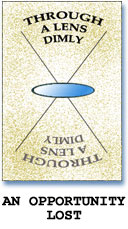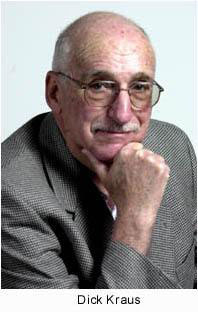|
|
|
|
|
|
THROUGH A LENS DIMLY AN
OPPORTUNITY LOST I'll tell you from the git-go that I'm changing the names of the people in this journal. I swear to you that the rest of the facts are as honest as I can recall them. I'm talking about actual events but it isn't my intention to cause embarrassment to those involved. Anyone who worked in our Photo Department in the '80's will know of whom I write. For the rest of you, it isn't really important that you know their identities. Just know that the events really did occur. Around 1983 the media started doing stories about the drought and famine in Ethiopia. The causes were attributed to the climate and the inter-tribal warfare that was and is endemic to the area. The news reports started talking about the tragedy that was responsible for thousands upon thousands of deaths. Newsday decided to send a team of reporters and a photographer to document the story. Oliver Mosler packed his cameras and some clothes. The team applied for and received visas from the Ethiopian Government and they flew to that East African country to tell the story. I don't remember for how long the team was gone; it was weeks, if not a month or more. At the time, I was working on an in-house project and had the opportunity to see Oliver's prints as they came out of the darkroom. There were photos of little children with the distended stomachs indicative of malnutrician. There were shots of large groups of people in refugee centers waiting for rations of food to be distributed. There was a massive relief effort underway by the UN and several countries; the United States among them. There were reports that most of the food never made it to the relief camps. Much of it ended up in the hands of the various tribal warlords. I had a nagging feeling about the photos that were coming out of the darkroom. First of all, they seemed very repetitious. There were too many pictures of bloated bellied babies that were all carbon copies of one another. There was no variety in angle or composition. They all seemed to be shot with the same lens and from the photographer's eye level point of view. The pictures of the crowds flocking around the trucks of food that entered the camp were all shot with the same wide angle lens from the same eye level perspective. In addition to the sameness of all the shots, there was something else that I couldn't quite put my finger on. I couldn't help trying to imagine what I might have done to make those photos more interesting; more imaginative; more relavent. I know that it's easy to be a Monday morning quarterback. You just don't know what kind of restrictions the photographer had to work under. But, damn! Oliver was a decent enough shooter. Just snapping on a longer lens to isolate one of those poor kids from the confusion of the camp background, or a low shooting angle could have worked wonders. I worked enough out of town stories to have developed a philosophy. The paper is spending big bucks to get you there and back. I think that it's incumbent upon me to put in some extra effort to make sure that there are some stand-out shots. Oliver did have one. It was a long lens shot of an emaciated child in a sling hanging from a scale as doctors recorded his weight. It was a good shot and it was the lead photo when Newsday began running the series of stories and photographs. But, after that, it was all uninspired sameness in the photos. Oliver began to fill the department in on what it was like over there. Because they entered Ethiopia on Government Visas, they were required to wait at their hotel for a government vehicle with an escort to pick them up and take them to a government approved relief camp. They could work unimpeded but their time in the camp was limited to a few hours each day and they couldn't go off on their own at any time. The result was that they spent a lot of time at a top rated hotel in Addis Ababa. Oliver admitted that he felt a bit embarrassed coming back from covering a famine weighing several pounds more than when he went. Obviously, the food at the Hilton was better and more plentiful than in the camps. I probably would have done the same. Several months after the series ran, the Pulitzer Prizes were announced. Newsday had submitted the series as a team effort as well as some individual entries, some of which were photos from the series. I was in the newsroom when the results came over the wires. When the chattering teletype spat out the good news that Newsday had won the prize for International Reporting for their Ethiopian Famine series, the newsroom erupted. Mack, our Chief Photo Editor and head of the Photo Department was ecstatic. He was dancing around the newsroom shouting, "We did it!! We won a Pulitzer Prize for Photography!!" Well, not quite. I pointed out that the prize went to the team, of which Oliver was a part. The news had just come over the wires that someone else had won the Pulitzer for News Photography. And, as it turned out, it was for the same story. Stan Grossfeld, Chief Photographer for The Boston Globe, was the recipient of that coveted honor. Our boss couldn't quite see how that was possible, but, it was. A few years later, I attended a National Press Photographer's Association Short Course up in Connecticut. One of the lecturers was that same Stan Grossfeld who talked about what he had to do to make those Pulitzer winning photos. As he spoke, I was impressed with his down to earth attitude and his modesty; traits with which very few of we newsphotographers (myself in particular) are blessed. Stan told how he and one reporter were denied visas from Ethiopia. Not to be deterred, the two of them were able to get to neighboring Sudan and under cover of darkness, they hiked across the border. They didn't have boxes of camera equipment nor did they have suitcases with clothes. They carried the bare minimum of equipment, film and clothes in backpacks. The stayed in no fancy hotels. They came back to Boston weighing much less than when they started out. The first day in Ethiopia, they came across a huge group of refugees who were preparing to leave their drought stricken village to look for food. Grossfeld and the reporter joined them as they set out. After several days of trekking across the desert, they came upon a ramshackle collection of tents. This wasn't the government sponsored refugee camp where the Newsday team was brought, that managed to get daily food and medical supplies, albeit scanty. This was an ad hoc assemblage where the occasional truck that got past the marauding war lords was set upon by desperate refugees hoping to get a morsel of food to feed their starving families. These are the scenes that were flashed on the screen by Stan Grossfeld. There was no sameness to his pictures. Each photo was a classic unto itself. They demonstrated that the architect of this showing was a master in his abililty to select just the right lens and angle to best illustrate what he was trying to say with his photography. They were assuredly worthy of the Pulitzer Prize for News Photography. One of Grossfeld's pictures stands out in my mind after all of these years. It was taken on the first day that he started out across the desert with the band of refugees. As they marched, they came across what had once been a farm. Now it was an ocean of wind rippled sand. Protruding from the sand were the bleached bones of a cow. Scattered about in the vicinity of the bones were a few blades of stunted, sun blasted grain. In the distant background was a line of the refugees marching across the sand dunes; victims of this drought causing famine. Grossfeld had placed his camera with an extreme wide angle lens, just inches above the sand when he made this exposure. It was the essence of the story. Oliver had allowed himself to be controlled by the dictates of the Ethiopian Government. His photos showed only the aftermath of the drought. Stan Grossfeld showed the drought itself and then the real aftermath; where people died daily from thirst and starvation. That was what that nagging question was when I first saw Oliver's pictures. I felt that something important was missing in our coverage. And it was. It was truly an opportunity lost. Dick Kraus |

